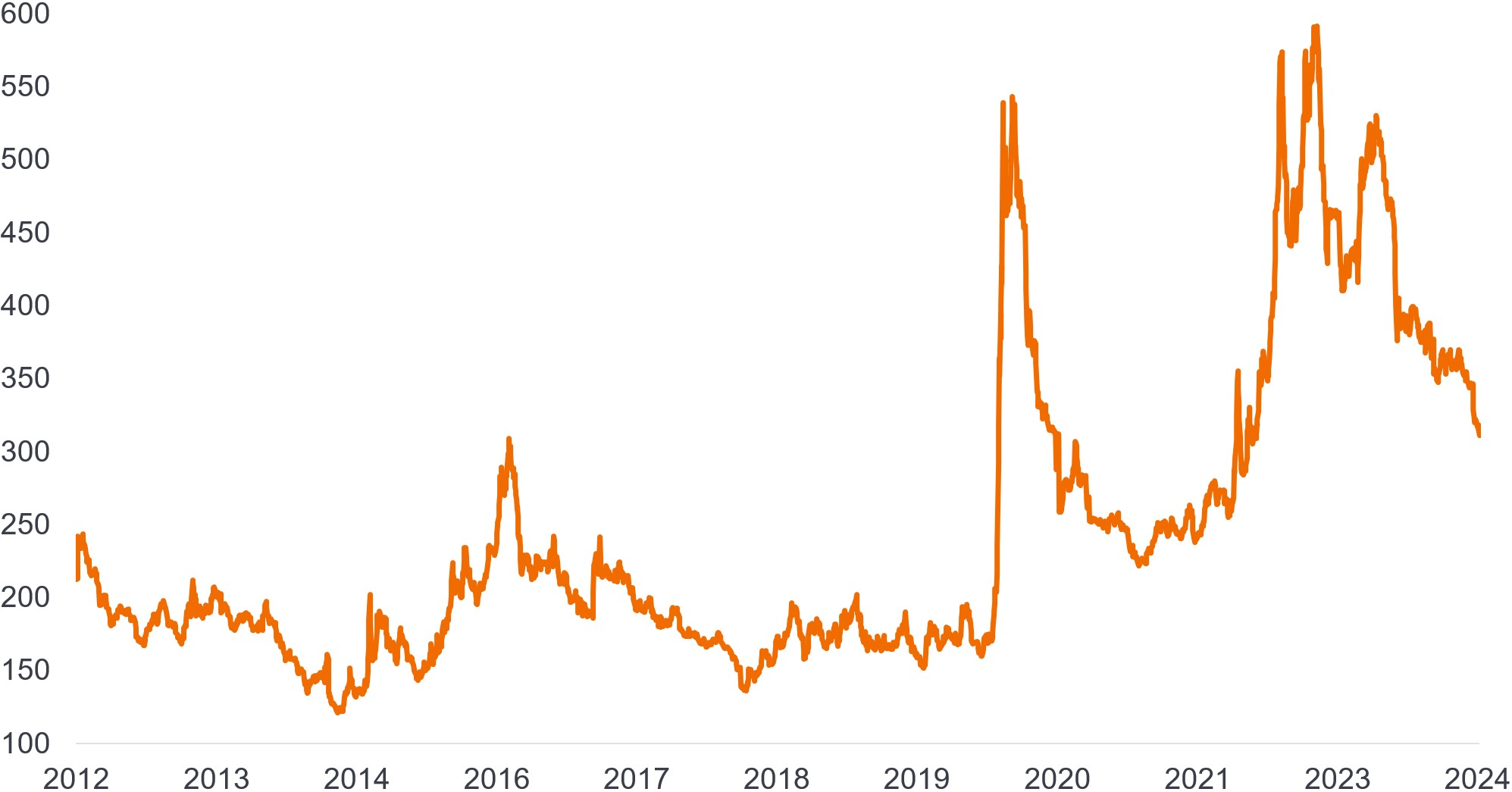Market access improving for EM debt issuers
After well over a year of struggling to access international financing, several lower rated high yield names in the sovereign emerging markets (EM) hard currency debt universe are now enjoying access to international bond markets. This positive change coincides with the upsurge in market sentiment globally, multilateral backing in the form of IMF programmes and investor appetite for a broad swathe of new bond issuance in the opening months of 2024, write EM hard currency debt portfolio managers Thomas Haugaard and Sorin Pirău.

8 minute read
Key takeaways:
- For much of the post-COVID period, we have seen a very significant widening of spreads for distressed names in the emerging markets (EM) hard currency debt universe, and a significant bifurcation in spreads between lower rated issuers and investment grade (IG) issuers.
- In 2024, continued signs of a more constructive overall global market environment have coincided with a compression – or normalisation – in the standard deviation of spreads in the EM debt hard currency universe, and renewed market access for some of the high yield (weaker) EM names that previously did not have access to international debt markets.
- Economically weaker countries enjoying market access of late include sub-Saharan African (SSA) countries like Ivory Coast, Benin and Kenya – that have managed to issue bonds with a very strong book in every issuance. Typically, EM high yield supply so far in 2024 has seen little in the way of new issuance concessions while performance post-issuance has been strong.
News flow on the economic and corporate front so far this year has had a definite “Goldilocks” feel to it. We’ve seen continued disinflation globally, economic surprise indicators in major markets in positive territory (with signs of stabilisation in China) and resilient earnings/growth. Admittedly, bullish US rate cut expectations that featured strongly in the fourth quarter of 2023 turned out to be a bit too optimistic (Fed speakers in February signalling they needed to see firm momentum in terms of easing inflation before cutting rates), but the broader risk-on sentiment has remained intact. Rate cuts – possibly beginning in Europe – are still on the cards in major Western economies and the economic soft-landing narrative is holding.
Alongside this more constructive overall market environment, there has been strong demand for bond issuance in the EM debt hard currency asset class. This is particularly impressive in view of the fact that the asset class has continued to see outflows year-to-date.1
One example is Panama’s record US$3.1bn triple-tranche issuance in February 2024. Despite the country’s fiscal challenges and Fitch Rating’s downward revision to the country’s rating last September from stable to negative, the issue was strongly oversubscribed.2
Year-to-date, most of the hard currency EM issuance has been investment grade (Panama is rated BBB-), but several high yield names have also successfully issued. Of the record US$44.3 bn sovereign EM hard currency bond issuance in January, 16% came from high yield names and the remaining 84% from IG names.3
The effect of these aforementioned positives has been very noticeable in the EM space, where we’ve seen significant spread tightening across the EMD hard currency universe, with aggregate spreads back to historical tights for the past decade (as of 29 February 2024). Also, we’ve seen some spread compression (high yield versus investment grade) and a decline in the standard deviation of spreads in the EM debt hard currency universe, as represented by the JP Morgan EMBI Global Diversified (EMBIGD). This decline is shown in Figure 1, which excludes countries with spreads higher than 2,000 basis points (bps).
Figure 1: Standard deviation of spreads in EMD hard currency
Standard deviation of spreads (excluding countries with spreads greater than 2000 bps)

Source: Janus Henderson, Macrobond and JP Morgan. Data from 5 July 2012 to 11 March 2024. Bps stands for basis points. One basis point equals 1/100 of a percentage point. Past performance does not predict future returns.
Coinciding with broad-based risk-on sentiment, the fall in the 10-year US government bond yield from its Q4 2023 peak and broadly strong investor appetite for new issues early in 2024 has been the advent of renewed market access for some of the weaker, lower-rated countries in the EM debt hard currency investment universe that had, in effect, been priced out of international debt markets for almost two years.4 Factors contributing to this reopening also include multilateral support (IMF programmes) for high-yield issuers as well as the implementation of Environmental, Social & Governance (ESG) frameworks and blended finance mechanisms, which have helped restore investor confidence.
High yield EM countries that have successfully tapped markets in 2024 include:
Ivory Coast (Côte dʼIvoire). In January 2024, Côte dʼIvoire issued two Eurobonds, worth US$2.6 billion in total. The one bond, a nine-year sustainability-linked bond, was priced to yield 7.875% and the second bond, a conventional Eurobond, was priced to yield 8.5% (with coupons of 7.625% and 8.25% respectively). Demand was reportedly three times oversubscribed.5 Côte dʼIvoire’s January 2024 issuance, which will reduce the country’s financing constraints, marks the first issuance by a frontier Sub-Saharan Africa (SSA) country in nearly two years.6 Côte dʼIvoire enjoyed further good news in early March 2024 in the form of a credit rating upgrade by Moody’s. Its local and foreign currency long-term issuer ratings and foreign currency senior unsecured ratings were raised to Ba2 from Ba3 (two notches below investment grade).7 Economic resilience and rising private sector investments underpinned the upgrade, which spurred a rally in the nation’s sovereign dollar bonds. Standard & Poor’s (S&P) rating for the country is BB minus with a stable outlook.
Benin. In early February 2024, Benin issued a US$750 million 2038 bond at a yield of 8.375% (coupon of 7.96%). The West African country’s debut US dollar bond was oversubscribed more than six times, attracting US$5 billion in demand. Benin is single-B rated and has benefited in recent months from the approval of an IMF facility (Resilience and Sustainability facility) reportedly worth around US$200m.8 The bond issuance aims to diversify the country’s sources of funding for developmental purposes. Benin is one of the fastest-growing economies in Sub-Saharan Africa and is projected to hit an average GDP growth of 6.1% in the 2024-25 period.9
Kenya. In mid-February 2024, Kenya successfully issued a $1.5 billion US dollar-denominated bond in international markets. While priced to yield slightly above 10% at issuance (coupon of 9.75%) – raising some concerns about the country’s public finances – the oversubscribed issue has helped ease fears of strains on the country’s foreign reserves and a possible default on an existing US$2 billion Eurobond that matures in June 2024. Alleviation of near-term event risk in Kenya will likely allow policymakers to focus more attention on fiscal consolidation plans and putting the country on a better structural footing for sustainable growth.10 Kenya, as of 9 February 2024, is single B rated by S&P with a negative outlook.
Montenegro. In early March 2024, this western Balkan country raised US$750mn from its first-ever US dollar bond issue. Investor demand totalled US$4.6bn, more than six times the amount on offer. Montenegro is single-B rated and its ratings outlook was raised from stable to positive in March 2024 by Standard & Poor’s. The borrowed funds will be used to pay down old debts and address fiscal debt in the current year.11
Brazil. While a less significant a story relative to the opening of Sub-Saharan Africa (SSA) markets, the dual tranche issue worth US$4.5bn by Brazil – another high yield name – in January 2024 is worth a mention. The dual issue came hard on the heels of an upgrade in late December 2023 to Brazil’s long-term credit rating (to BB from BB-minus, by Standard and Poor’s), following the country’s approval of a structural tax reform.
EM high yield supply momentum in 2024 year-to-date and indications that borrowing costs are beginning to decrease in African countries is good news given the widening sovereign dollar bond spreads and debt distress in Sub-Saharan Africa (SSA) – for example in Kenya, Nigeria and Angola – seen in much of 2023. While significant spread differences remain, the more recent easing (Côte dʼIvoire being an example) bodes well for debt risk in Africa.
Reopening market access has also had a positive ESG angle. We have already mentioned Côte dʼIvoire’s US$1.1bn sustainable bond, the proceeds of which will be used for renewable electricity, waste and water management, urban and rural development, education, healthcare and biodiversity. Meanwhile, Kenya, in January 2024, ratified a framework for the issuance of green bonds for climate mitigation and adaptation, and Angola has indicated that it may issue its first sovereign green bond in 2024.12
In our view, we continue to see EM frontier markets as offering some attractive carry and relative value plays within our universe. Despite the continued outflows we have seen in the EM hard currency debt space overall so far in 2024 (with investors more recently tending to favour developed market bonds and – in the EM space – local currency bonds, which are relatively more sensitive to changes in economic sentiment), we believe the case for EM hard currency debt asset class continues to build, thanks, inter alia, to the considerable economic growth forecast differential that exists between developed and emerging countries, post-Covid fiscal consolidation and economic reforms in several emerging markets, the significant underweight exposure to this asset class in global portfolios, and the virtuous circle created by capital markets being open to more and more credits (a major positive for the 8-10+% yielding cohort). We would not be surprised to see a turn in flows in the second half of 2024.
1 Year-to date, as of 8 March 2024, outflows from dedicated EM debt sovereign hard currency funds totalled US$3.35bn. Source: EPFR and Morgan Stanley.
2 Source: Fitch Ratings, Rating Action Commentary, 23 February 2024.
3 EM hard currency sovereign debt issuance in January 2024 of US$44.3bn is a record. This figure for January 2024 equates to 40% of the total issuance of EM hard currency sovereign debt in 2023 (US$112 billion) and is the highest ever issuance of EM hard currency sovereign debt on record for the month of January. Source: Tellimer Insights, Bond Radar data. Meanwhile, sovereign issuance continued to be strong in February and early March of 2024; Morgan Stanley reported year-to-date sovereign issuance (as of 8 March 2024) of US$80bn. Source: Morgan Stanley EM Fixed Income flows update: Where Supply meets Demand; 8 March 2024. Data from Bloomberg, Bond Radar and Morgan Stanley Research.
4 US 10-year Treasury yields hit a multi-year peak of 4.98% on 19 October 2023. February 2024 saw UST 10-year yields back up to 4.33%, but this is still lower relative to the Q4 2023 highs. As of 8 March 2024, the UST 10-year yield stood at 4.09%. Source: Y-charts.
5 Source: Tellimer Insights; 16 February 2024.
6 For more than a year, sub-Saharan African (SSA) countries have endured a severe funding drought. Reasons include the economic impact of the Covid-19 pandemic, increased geopolitical uncertainty, globally inflated prices, elevated US interest rates and a strong US dollar. International investors could enjoy attractive yields by investing in much less risky developed market bonds (e.g., US Treasuries), and many African countries found themselves effectively priced out of capital markets. At the same time, African government’s spending had increased due to the Covid-19 pandemic and the global price crisis, which – along with US dollar strength – bumped up debt servicing costs. In several African countries, debt service and amortization already exceed 50% of government revenue. Without access to international financing, many SSA countries have had to rely heavily on the IMF and the World Bank, whose lending has grown significantly in the current decade.
7 Source: Moody’s Investor Service, 1 March 2024. According to Moody’s, the upgrade reflected the country’s “increased economic resiliency supported by growing economic diversification, rising income levels from a low level and robust economic prospects, all driven by rising private sector investments, and a track record of steady improvements in governance. Additionally, ongoing fiscal consolidation efforts under the current IMF program and efficient management of the government debt profile, will result in durable improvements in government fiscal metrics and reduced liquidity risks. Moodyʼs expects Côte dʼIvoireʼs economic performance will be broadly resilient to shocks emanating from the political crisis in West Africa while domestic political will likely continue to wane. According to the agency, despite the rapid growth of Côte dʼIvoireʼs economy, the risks of emergence of large imbalances remain low in part thanks to the macro financial stability derived from participation in the West African Economic and Monetary Union (WAEMU) and the large IMF programme. According to Moody’s, Côte dʼIvoireʼs commitment to fiscal consolidation means the gradual decline of the debt burden towards 50% of GDP by 2030, and associated improvement in government fiscal metrics, are unlikely to be derailed.
8 Source: BNP Paribas, Bloomberg, IMF. February 2024.
9 Source: Macrobond and IMF World Economic Outlook, estimate, constant prices, year-on-year change.
10 Following the issuance of the new bond, Kenya’s cabinet has decided to add more assets to the list of assets earmarked for privatisation. Source: EMsights Capital Group as of 26 February 2024.
11 In this bucket of single Bs, potential contenders for issuance this year include Angola, Nigeria, El Salvador and Egypt. Source: Morgan Stanley, EM Sovereign Credit Strategy, 27 February 2024.
12 Source: Xinhua, 15 January 2024. In 2023, Kenya was adversely impacted by a drought and El Nino rains that were months apart.
Active investing. An investment management approach where a fund manager actively aims to outperform or beat a specific index or benchmark through research, analysis and the investment choices they make. The opposite of Passive Investing.
Basis point (bp). One basis point equals 1/100 of a percentage point. 1 bp = 0.01%, 100 bps = 1%.
Bond. A debt security issued by a company or a government, used as a way of raising money. The investor buying the bond is effectively lending money to the issuer of the bond. Bonds offer a return to investors in the form of fixed periodic payments (a ‘coupon’), and the eventual return at maturity of the original amount invested – the par value. Because of their fixed periodic interest payments, they are also often called fixed income instruments.
Bond yield. The level of income on a security expressed as a percentage rate. For a bond, this is calculated as the coupon payment divided by the current bond price. There is an inverse relationship between bond yields and bond prices. Lower bond yields mean higher bond prices, and vice versa.
Carry. The meaning of ‘carry’ is dependent on the context used. For a bond investor, a typical definition would be the benefit or cost of holding an asset, including any interest paid, the cost of financing the investment, and potential gains or losses from currency changes.
Credit rating / credit quality. An independent assessment of the creditworthiness (credit quality) of a borrower by a recognised agency such as Standard & Poor’s, Moody’s or Fitch. Standardised scores such as ‘AAA’ (a high credit rating) or ‘B’ (a low credit rating) are used, although other agencies may present their ratings in different formats.
Credit spread. The difference in yield between a corporate bond and a benchmark rate (e.g., yield on a government bond). It gives an indication of the additional risk that lenders take when they buy corporate debt versus government debt of the same maturity. Widening spreads generally indicate a deteriorating creditworthiness of corporate borrowers, while narrowing indicate improving.
Current account deficit. A current account deficit (CAD) exists when the value of goods and services imported by a country exceeds the value of the goods and services that it exports.
Dispersion. A measure for the statistical distribution of given data. There are several methods to measure dispersion, also sometimes referred to as “scatter” or “variability”.
GDP: The value of all finished goods and services produced by a country, within a specific time period (usually quarterly or annually). It is usually expressed as a percentage comparison to a previous time period and is a broad measure of a country’s overall economic activity.
High yield bond. A bond with a lower credit rating than an investment grade bond, also known as a sub-investment grade bond, or ‘junk’ bond. These bonds usually carry a higher risk of the issuer defaulting on their payments, so they are typically issued with a higher interest rate (coupon) to compensate for the additional risk.
Investment grade (IG). A bond typically issued by governments or companies perceived to have a relatively low risk of defaulting on their payments, reflected in the higher rating given to them by credit ratings agencies.
JP Morgan EMBI Global Diversified Index (EMBIGD). This index tracks liquid US dollar emerging market fixed and floating-rate debt instruments issued by sovereign and quasi-sovereign entities and is a widely followed benchmark.
International Monetary Fund (IMF): The IMF is a global organization that works to achieve sustainable growth and prosperity for all its 190 member countries. It does so by supporting economic policies that promote financial stability and monetary cooperation, which are essential to increase productivity, job creation and economic well-being. The IMF is governed by and accountable to its member countries.
Monetary policy. The policies of a central bank, aimed at influencing the level of inflation and growth in an economy. It includes controlling interest rates and the supply of money. Monetary stimulus refers to a central bank increasing the supply of money and lowering borrowing costs. Monetary tightening refers to central bank activity aimed at curbing inflation and slowing down growth in the economy by raising interest rates and reducing the supply of money.
Soft landing. A situation in which a central bank succeeds in bringing down inflation without significantly harming employment and economic growth levels.
Important information
Volatility measures risk using the dispersion of returns for a given investment.
Credit Spread is the difference in yield between securities with similar maturity but different credit quality. Widening spreads generally indicate deteriorating creditworthiness of corporate borrowers and narrowing indicate improving.
Swaps, if any, are reported based on notional exposure.
There is no guarantee that past trends will continue, or forecasts will be realised.
Fixed income securities are subject to interest rate, inflation, credit and default risk. The bond market is volatile. As interest rates rise, bond prices usually fall, and vice versa. The return of principal is not guaranteed, and prices may decline if an issuer fails to make timely payments or its credit strength weakens.
High-yield or “junk” bonds involve a greater risk of default and price volatility and can experience sudden and sharp price swings.
Beta measures the volatility of a security or portfolio relative to an index. Less than one means lower volatility than the index; more than one means greater volatility.
These are the views of the author at the time of publication and may differ from the views of other individuals/teams at Janus Henderson Investors. References made to individual securities do not constitute a recommendation to buy, sell or hold any security, investment strategy or market sector, and should not be assumed to be profitable. Janus Henderson Investors, its affiliated advisor, or its employees, may have a position in the securities mentioned.
Past performance does not predict future returns. The value of an investment and the income from it can fall as well as rise and you may not get back the amount originally invested.
The information in this article does not qualify as an investment recommendation.
Marketing Communication.

